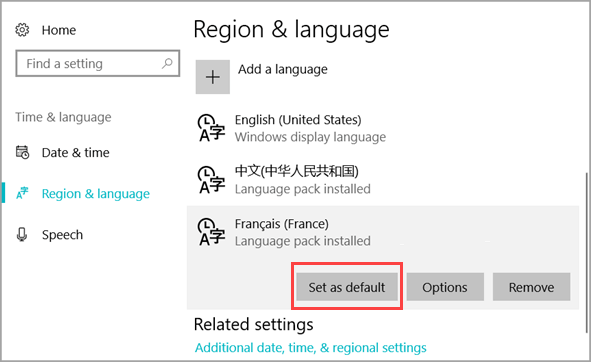


The Rosetta Stone’s legacyĬhampollion used the stone to create an alphabet of phonetic hieroglyphic characters, then other scholars piggybacked on his research to fully translate the stone. Then he fainted and did not recover for five days. Famously, an ecstatic Champollion rushed into his brother’s office shouting “ Je tiens mon affair!” (“I’ve got it!”). He figured out that the demotic script-the third writing system on the stele-conveyed syllables and that the hieroglyphs represented Coptic sounds.

Where Young had no experience with the Egyptian language, Champollion was fluent in Coptic and had extensive knowledge about Egypt.
HOW TO INSTALL ROSETTA STONE ENGLISH LANGUAGE PACKS CODE
by Unknown Artist, (19th century).īut it was Jean-François Champollion, a Frenchman known as the founder of Egyptology, who would ultimately crack the code in 1822. Portrait of Jean François (Jean-Francois) Champollion, dit le Jeune (1790 - 1832) French Egyptologist. © Illustration by unknown artist via Bridgeman Images Young was able to identify the phonetic sounds some glyphs represented, figure out some of the characters, and piece together how words were pluralized. He also compared the glyphs to those on other statues. After translating the ancient Greek, he took extensive notes on the hieroglyphs and systematically attempted to match each one to its translation. Thomas Young, a British polymath best known for his scientific contributions, treated the mystery as a mathematical problem. Though a variety of scholars across Europe would contribute to the work, the two most important contributions came from England and France. Scholars raced to translate the Rosetta Stone. Since it contained identical content in three languages, scholars thought the Rosetta Stone might be able to help crack the historic mystery. Scholars had long puzzled over the meaning of the picture-like markings, known as hieroglyphs, made on ancient Egyptian slabs. The Rosetta Stone’s codeīut the stone had more than aesthetic value. So in 1802 the Rosetta Stone made its way to London, where it was put on display at the British Museum almost immediately upon arriving. The French were allowed to evacuate, but the British demanded they hand over the antiquities collection before leaving. The Egyptologists gathered a large number of ancient artifacts they wanted to take back to France, including the Rosetta Stone.īut the British wanted Egypt, too, and in 1801 they prevailed over French forces. Scientists and historians were part of the conquering force, and streamed into the country to document what they found there. 196 BC.įast-forward to 1798, when Napoleon led French forces to take over Egypt, which was then part of the Ottoman Empire. © Photograph via Prisma Archivo/Alamyĭetail of the Rosetta Stone. Identical stelae were to be placed in every temple in Egypt. It was recorded on the stele in Ptolemaic hieroglyphics, Demotic Egyptian script, and ancient Greek script. The decree was passed by a council of priests who used it to honor the pharaoh and declare their loyalty to him. It consists of a decree affirming the royal cult of Ptolemy V Epiphanes, an Egyptian king who took the throne in 204 B.C.Īt the time, the Ptolemaic kingdom was at war and dealing with an internal revolt. But though its text is incomplete, it is invaluable. Standing at about four feet high and 2.5 feet wide, the granite-like rock is just a fragment of a larger, now lost, stele. But first, scholars would have to crack its code. The slab was the Rosetta Stone, and the letters and symbols carefully chiseled into its dark face would shed light on the glory of ancient Egyptian civilization. He shared his find with French scholars who had come to plumb Egypt for archaeological treasures. Intrigued, Bouchard wondered if the stone might say the same thing in three different languages. Discovered near Rosetta in Egypt in 1799, became key to deciphering Egyptian inscriptions British MuseumĪs the men tore down a wall that had been built using the detritus of nearby ancient Egyptian sites, they discovered a large stone fragment covered in three types of writing, including ancient Greek. Rosetta Stone: Basalt slab inscribed with decree of pharaoh Ptolemy Epiphanes (205-180 BC) in three languages, Greek, Hieroglyphic and Demotic script. © Photograph via Universal History Archive/UIG/Bridgeman Images The French soldiers occupied a run-down fort in Rosetta, Egypt, and had just days to shore up their defenses for a battle with Ottoman Empire troops. When Pierre-François Bouchard’s men discovered the ancient stone slab that would change the world on July 19, 1799, they weren’t on an archaeological dig they were doing a last-minute construction job.


 0 kommentar(er)
0 kommentar(er)
